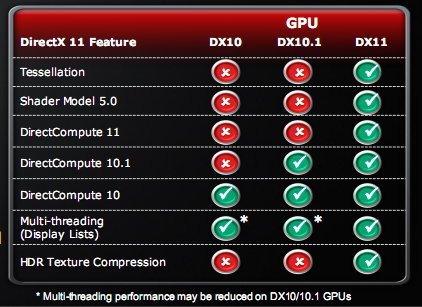Not just about hardware. DX11 leads the way
DX11
Microsoft's Windows 7 operating system, to be launched on October 22nd, will ship with an upgraded graphics API (application programming interface) in the form of DX11. The API will also be available for Windows Vista a few days later via an update.One of the main purposes of an update to a graphics API is to provide developers with a standardised, enhanced feature-set which makes it simpler to author code for better-looking effects.

DX11 brings tesselation, multi-threading, and GPGPU to the fore
Tessellation
How do you make a game character look more realistic? Increasing the polygon count, the building-block for graphics, is one method. The innate problem in increasing scene-wide polygons is one of computational resources. Graphic artists put forward high-detail (many-triangle) models that stretch the CPU's ability to process them.
Hardware tessellation, now standardised in DX11, attempts to get around the problem by getting the GPU to undertake much of the donkey work, by adding a substantial number of 'patches' to low-polygon models and thereby generating the necessary geometry for high-detail characters. Technically, DX11 uses what are termed as 'hull' and 'domain' shaders, alongside the fixed-function tessellation unit, to turn low-polygon models into complex geometry.
Heard about tessellation before? The actual hardware has been around for a number of years, with the most high-profile implementation being the Xbox 360 gaming console. The DX11 API now standardises its use....finally.









